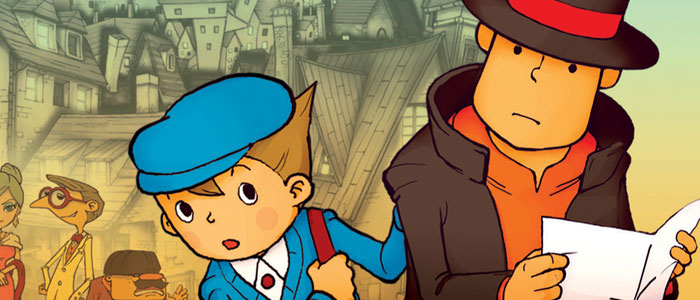Welcome to the curious village of St. Mystere, a perfect getaway for gamers hungering for a point-and-click brain bender of an adventure. Much like any other European town, St. Mystere is just head over heels for puzzles and the eclectic lot of village-folk won’t give up a scrap of info until you prove sufficient mastery over them, from math to logic to just plain riddling.
Professor Layton and his young apprentice Luke are called to St. Mystere to solve the mystery of the Golden Apple, where not-so-surprisingly they are met with a fitting amount of intrigue, silly characters, and a smattering of murder. Layton and Luke travel about the town uncovering clues, more mystery and of course, solving puzzles. While many of the riddles can be saved for a later time, the crux of the game is going to the trouble of solving them – take out the puzzles and it’s all rather lean and purposeless.
As a point-and-click there are plenty of secrets to uncover, be they hidden puzzles or an astonishing number of hint coins. As the name suggests the latter are used to unlock the three available hints during puzzle solving should you find yourself baffled. While this may make the game more kid-friendly, in most cases the first two hints are a waste of coin. The puzzles, even at their easiest, will give you pause though overall they are completely manageable with the occasional stumper. From pour the liquid style puzzles to tile sliders to safe transport of farm animals, many are just trick questions aimed at the truly devious. It is hard not to appreciate the variety offered, and while the math-based ones made me feel like I needed to retake the fifth grade, trouncing the logic puzzles is downright satisfying.
Most of the puzzling comes as a means of obtaining clues from the villagers, and this puzzle-happy phenomenon extends to the objects of the town as well. Be it a stream that reminds Layton of a riddle or perhaps Luke’s fondness for local fauna prompting a mammal-themed quandary, players won’t get far without bumping into something, well, curious. These hidden puzzles uncover more of the village’s mysteries, and Professor Layton typically seizes the opportunity to spring a puzzle of his own on Luke. Any chance to impart gems like: “One must always put a lady’s needs first, that’s what a gentleman does.” Saucy Professor!
Each successfully solved puzzle fills your pocketbook with Picarats and is assigned a different worth based on difficulty. I vaguely remember a promise at game start that by earning Picarats “something good” would happen, which quickly had me shouting “Lying bastards!” Spare yourself similar distress: the Picarats can be used in the Bonuses section. Failing to answer a question correctly decreases the number of Picarats players can earn on a given puzzle, though the bottom only falls a fixed amount per question which means you can randomly guess away and only risk missing out on ten Picarats or so. If stumbling through the solutions that way holds draw for you, prepare to feel plain giddy: cheating is dead easy. After figuring out the right answer by less than careful elimination, you can simply turn the game off and start again. Gamers might expect the top-hatted master of cleverness to get wise, but Layton just turns a blind eye to the maneuver. It’s laughable, and it wouldn’t be much to critique if puzzles weren’t the point of the game. Where’s the European equivalent of Mr. Resetti for all those cheating fools?
There’s some additional puzzling type activities rounding out gameplay, including a bit of furniture collection that players must arrange to Luke and Layton’s liking. Solving many puzzles rewards you with painting scraps or gizmos for assembly, though each is dumbed down to the point of insult. Completing these tasks as well as the main quest unlocks Layton’s Challenges, trios of puzzles of the Professor’s own devising guaranteed to delight. The Wi-Fi also promises to serve up a weekly puzzle, though I confess that by game’s end I wasn’t quite as puzzle hungry as those St. Mystere folks. A handful of puzzles may have you firing up the game after its conclusion (tile-sliders that can be completed in as little as twelve moves, for example) but for the most part once they are puzzled out they aren’t worth returning to. Unless, of course, you’re really into sharing puzzles with your friends at social engagements.
The Professor has already found fame in Japan, and it’s clear the guy is good at what he does. Curious Village is unequivocally pretty; the well-styled visuals are clean and simple, true to the content and very, well, classy. Bundled up neatly with some excellent, if limited, voice-acting the whole package lives up to the Layton hype. A really solid point-and-click puzzling experience tailor-made for the handheld, Curious Village is like all those brain training games toured Europe and came back fun, savvy and with an infinitely better wardrobe.
